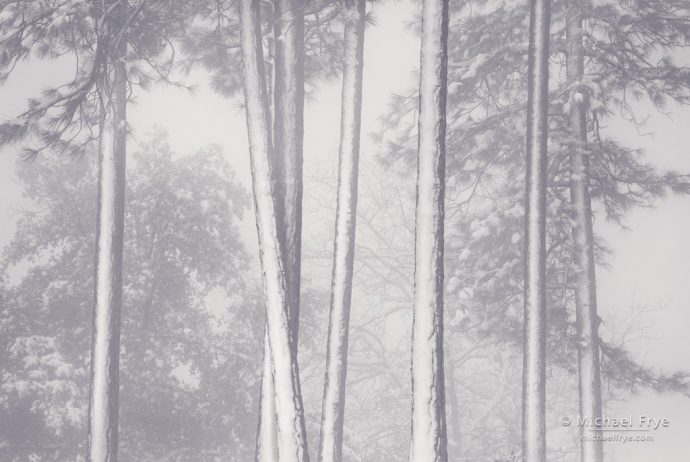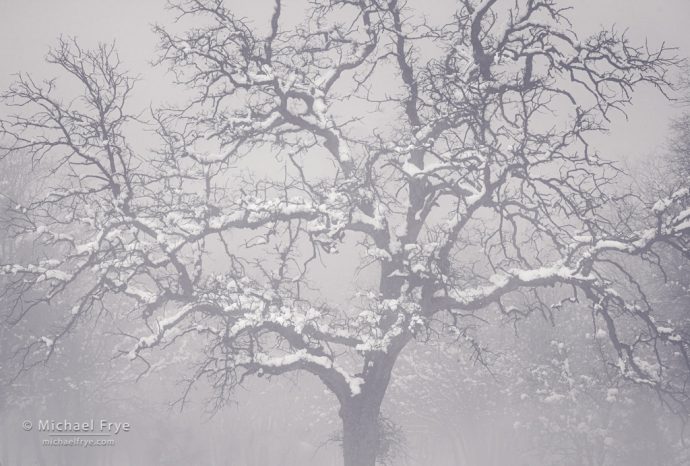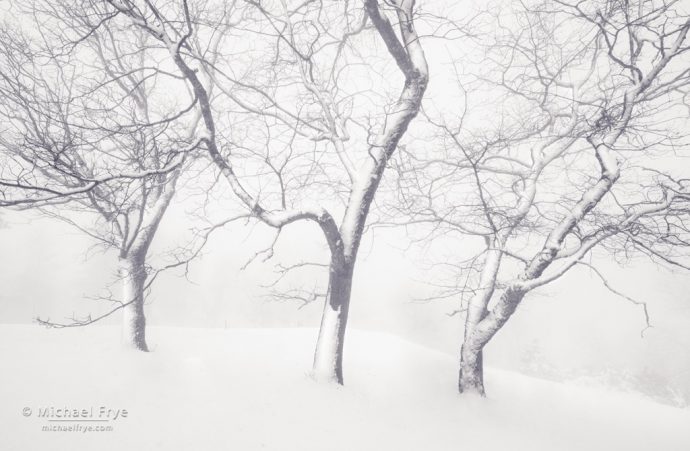
Snow-covered pines, Mariposa County, California. I found some snow-plastered trees in the fog as the storm was clearing.
Last week’s big storm played out mostly as predicted, dropping large amounts of rain and snow throughout much of California. The Yosemite area was right in the bullseye of the atmospheric river, but all of the Sierra Nevada got a healthy dose of rain and snow. Yosemite Valley’s rain gauge measured 6.67 inches. Other nearby areas received amounts ranging from four to eight inches, with one weather station just south of Yosemite recording slightly over ten inches.
Coastal mountains areas from Santa Cruz down to Santa Barbara reported impressive rainfall totals, with ten inches of rain in many gauges, and one spot along the Big Sur Coast, Chalk Peak, recording over 15 inches of rain in three days. A mudslide near Salinas damaged a number of buildings, and a section of Highway 1 south of Big Sur got washed out, but I think we were lucky to escape this big storm without more widespread damage.
Of course most of the precipitation fell as snow in the higher elevations of the Sierra. The National Weather Service predicted the snow level would be at about 4,500 to 5,000 feet through most of this storm, but in Yosemite Valley, at 4,000 feet, the temperature never got above 33 degrees (about .5 Celsius), so it all fell as snow – albeit wet snow. I’m not sure what the total snow accumulation was in the Valley, because I haven’t been able to get up there; from what I can gather it was between one and two feet. But the weight of all that wet, waterlogged snow brought down numerous trees and limbs. At one point the park issued a shelter-in-place order for employees and residents due to the danger of falling branches.
Not surprisingly, the park extended the closure to visitors until tomorrow (Monday, February 1st). Also, the park announced they will restart the day-use reservation system. Beginning February 8th, you’ll need a reservation for either a campsite or hotel within the park (El Portal doesn’t count), or a day-use reservation to get into Yosemite. Day-use reservations can be made online starting tomorrow (Feb. 1st) at recreation.gov.
In the Yosemite high country, the winter rangers stationed in Tuolumne Meadows measured 82 inches of new snow. Over on the eastern side of the Sierra, the upper part of Mammoth Mountain received 113 inches of snow during the storm. And Highway 395 between Bishop and the Nevada state line was closed for at least 36 hours because of blizzard conditions.
At our house in Mariposa we got a couple inches of snow at the beginning of the storm before temperatures climbed and the snow turned to rain. Then we got a couple more inches of wet snow at the tail end of the storm as the temperature dipped.
Since Yosemite was closed, I thought about other locations I could photograph when the storm started clearing. As the end of the storm approached on Friday morning I headed for one of those locations – a higher-elevation spot that I was sure would have a good amount of snow – only to find that the road was blocked by PG&E crews working on a power line!
Now what? Time for plan… C? I decided to check out another area that I thought would have snow, even though it isn’t quite as high. I found about seven inches on the ground, and better yet, fog. So I spent a couple of enjoyable hours walking along unplowed back roads photographing snowy trees in the fog, and I’ve included a few of those images here.
Another storm is expected on Tuesday and Wednesday, but this one will be much smaller, and warmer. All the precipitation should fall as rain in Yosemite Valley, except for perhaps a slight dusting of snow when temperatures dip at the tail end of the storm.
And after that… dry. This storm was a big help, but we need more rain and snow. Let’s hope the wet pattern returns later in February!
— Michael Frye
Related Posts: Riding Out the Storms; A Monster Storm
Michael Frye is a professional photographer specializing in landscapes and nature. He is the author or principal photographer of The Photographer’s Guide to Yosemite, Yosemite Meditations, Yosemite Meditations for Women, Yosemite Meditations for Adventurers, and Digital Landscape Photography: In the Footsteps of Ansel Adams and the Great Masters. He has also written three eBooks: Light & Land: Landscapes in the Digital Darkroom, Exposure for Outdoor Photography, and Landscapes in Lightroom: The Essential Step-by-Step Guide. Michael has written numerous magazine articles on the art and technique of photography, and his images have been published in over thirty countries around the world. Michael has lived either in or near Yosemite National Park since 1983, currently residing just outside the park in Mariposa, California.











I love the way you produced these photos – so beautiful!
Thank you Debra!
It is a joy to participate in the recent storms through your story and lovely photos. Thank you.
Glad you enjoyed it – thanks!
Love these. Trees are surprisingly difficult to shoot.
Thanks Carolyn. Trees can be difficult, for sure. There’s often lots of clutter and visual confusion. Fog is very helpful, since it helps to hide the background and simplify things. Of course it’s possible to make good tree photographs without fog, but fog makes it much easier.
I’m amazed and the relatively low contrast. Beautiful subjects presented in subtle light.
Thanks Sean! I think of contrast as a tool to express what you want to express about the scene. In this case part of the point was the low contrast, white-on-white look, and the softness created by the fog. I felt that adding more contrast would have made it too harsh and ruined that softness.
Well done, Michael! I especially like “Snowy oaks!”
Thanks so much Bill!
Hi Michael,
The first is so ethereal. Such an awesome “mood” shot.